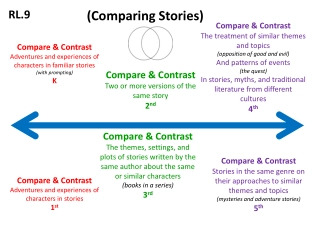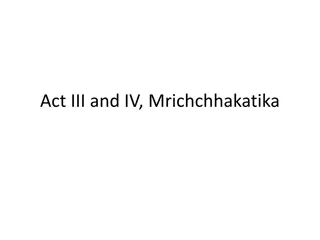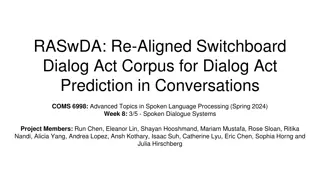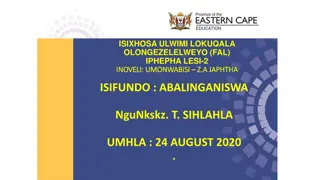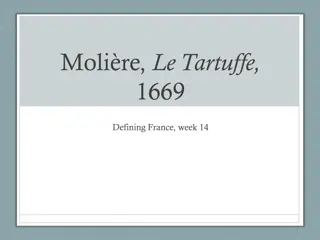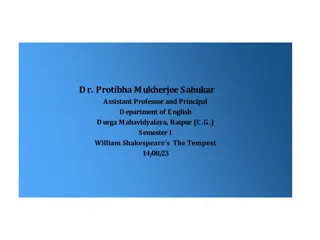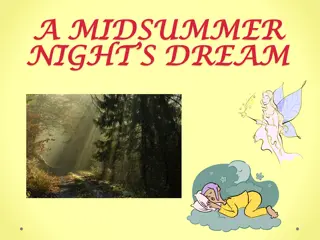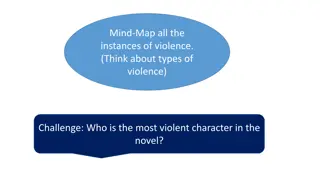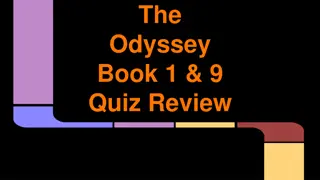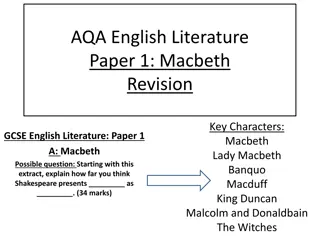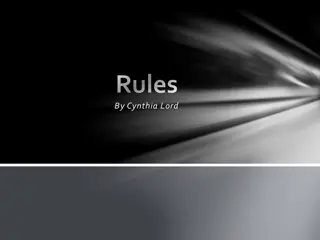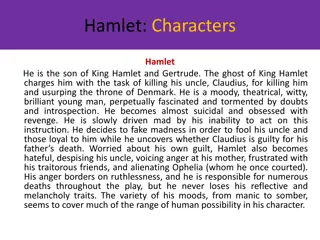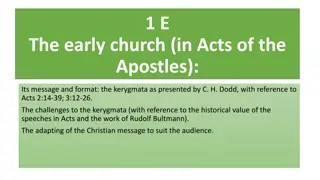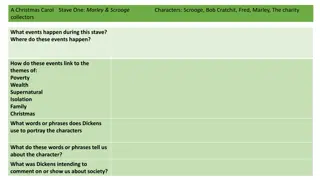Analysis of Characters and Themes in "The Home and the World" and "Betrayal: An Analysis in Three Acts
A detailed examination of character portrayals in the films "The Home and the World" and "Ghaire Baire" by Satyajit Ray, based on Rabindranath Tagore's novel. The analysis delves into nuances of love, betrayal, and strategic intentions of the characters. Additionally, insights into feminist theory, difference problem, and accountable positioning are explored.
Download Presentation

Please find below an Image/Link to download the presentation.
The content on the website is provided AS IS for your information and personal use only. It may not be sold, licensed, or shared on other websites without obtaining consent from the author.If you encounter any issues during the download, it is possible that the publisher has removed the file from their server.
You are allowed to download the files provided on this website for personal or commercial use, subject to the condition that they are used lawfully. All files are the property of their respective owners.
The content on the website is provided AS IS for your information and personal use only. It may not be sold, licensed, or shared on other websites without obtaining consent from the author.
E N D
Presentation Transcript
The Home and the World Film Review
Character Analysis Ghaire Baire1984, directed by Satyajit Ray based on the novel The Home and the World by Rabindranath Tagore The film portrays Sandip as being genuinely in love with Bimala; we do not have access to the internal monologues of each character, therefore, an audience unfamiliar to the novel would not be fully aware of the monstrous character and full intentions of Sandip until near the end of the film. Bimala is portrayed as being innocent, the same issue mentioned above allows us to remove any responsibility on her part concerning her affair with Sandip; her wild nature is portrayed as subtle curiosities which leaves her trapped. Nikhil is portrayed as reflective, the subtle foolishness that can be seen in his character in the novel is not present, he is instead seen as strategic.
Betrayal: An Analysis in Three Acts Kamala Visweswaran
The Players Uma Janaki Tangam Kamala Visweswaran Uma s first husband Subramanian (Uma s 2ndhusband) Brahmin priest (Janaki s 1sthusband) Ramachandran (Janaki s 2ndhusband)
Definitions Epistemology: a branch of philosophy investigating the origin, nature, methods and limits of human knowledge. Ethnography: Scientific description of people and culture with their customs, habits and mutual differences. Brahmin: the highest Hindu caste, traditionally of the priesthood. Satyagraha: A policy of passive political resistance advocated by Ghandi against British rule in India.
Difference Problem we keep returning to throughout the course which is well mapped out here. We prefer to find similarity than to attempt the difficult task of processing difference. feminist theory is repositioning itself along the lines of difference yet it remains a struggle to let go of the earlier notions of sisterhood.
Accountable positioning http://monoskop.org/images/f/f3/Haraway_Donna_J_ Simians_Cyborgs_and_Women_The_Reinvention_of_N ature.pdf Pg. 196 - Feminist embodiment resists fixation and is insatiably curious about the webs of differential positioning. There is no single feminist standpoint because our maps require too many dimensions for that metaphor to ground our visions. But the feminist standpoint theorists' goal of an epistemology and politics of engaged, accountable positioning remains eminently potent.
Silence and Power Relations Information holds power, by not revealing this the power is transferred to the individual e.g. Janaki Visweswaran wants the power of this information in her text, but by narrating the events in the way she does she is able to leave residual power with Janaki by articulating the unravelling of her story rather than just the end resulting facts.
Class Class is established through a mix of caste, economic status, and for women marital and familial status. Economic status seems to be the dominant though as despite being Brahmins (the highest caste) Janaki s brother warns she will be classified as Class C if she is arrested because they are poor. Uma on the other hand in identifying as a chaste wife and assimilating the class factors of her husband is classified as Class A. Class is a complicated combination of factors which is especially difficult to navigate for women as much of their identity is formulated through relations to men.
Official History and Knowledge Factual evidence not only justifies the ideas of the historian/ethnographer/anthropologist presenting it but also becomes more true by being recorded in this way. Mutually beneficial two way exchange we should be wary of. Is the version of events relayed here more or less authoritative than the official records? Where do the accounts of Uma and Janaki fit into this hierarchy?
Identity, Reality and Truth How do we reconcile ethnography as a scientific pursuit (and consequently subject to questions of truth) with the notion that identity is entirely social and therefore reality is subjective? Framing identity as a performance does it undermine Uma and Janaki s subjectivity?
Betrayal and Agency Betrayal is an assertion of agency by juxtaposing your control of the situation with the lack of control of the person being betrayed. Janaki constructs her own agency through the projected nonagency of another woman
Further Questions Can there be a feminist ethnography? Are the two incompatible? Who has the most power in this text? Can we define Janaki as active and Uma as inactive ? Is Kamala Visweswaran a secondary character in the text? Feel free to address any of the other questions throughout the powerpoint.
The Nation and its Fragments Partha Chatterjee
The Womens Question the diminished importance of the women s question in the period of nationalism [it] did provide an answer to the new social and cultural problems concerning the position of women in modern society [through] situating the women s question in an inner domain of sovereignty [by focusing on] the political encounter between a colonial state and the supposed tradition of a conquered people
Colonialism colonialism [ ] saw itself performing a civilising mission [by] transforming the figure of the Indian woman into a sign of the inherently oppressive and unfree nature of the entire cultural tradition of a country by underestimating the value of Indian Nationalism and interrogating its intent and content criticism of the degenerate and barbaric social customs of the Indian people, sanctioned by the religious tradition. i.e. the position of women in society reflects the position of the country. Critics justify colonialism by focusing on the barbaric rituals derived from religion which oppress women i.e. in order to become successful, you must liberate your women; you can do this by abandoning all your religious and cultural practices and replacing them with ours. The excerpt of an account from an early nineteenth-century British traveller in India: demonstrates the plight of the Indian woman which could serve as an excuse to colonize. It showcases a total moral condemnation of a tradition that was seen to produce and sanctify [ ] barbarous customs.
Dichotomy of Nationalism nationalism separated the domain of culture into two separate spheres the material and the spiritual. The world is the external, the domain of the material; the home represents one s spiritual self, one s true identity. Reflection equations Material world: modernisation (world) + dangerous = male Spiritual World: tradition (home) + sacred = female To overcome this domination, the colonized people had to learn those superior techniques of organizing material life and incorporate them within their own cultures But this could not mean the imitation of the west in every aspect of life, for then the very distinction between the West and the East would vanish the self-identity of the national culture would itself be threatened. Nationalism saw a struggle for the balance between the two: the material and spiritual: the home and the world.
Modernisation Colonialists: modernisation over tradition=autonomy Sandip: tradition over modernisation=autonomy Nikhil: tradition and modernisation=autonomy As long as India took care to retain the spiritual distinctiveness of its culture, it could make all the compromises and adjustments necessary to adapt itself to the requirements of a modern material world without losing its true identity The subjugated must learn the modern sciences and arts of the material world from the West in order to match their strengths and ultimately overthrow the colonizer [however] the crucial need was to protect, preserve and strengthen the inner core of the national culture, its spiritual essence. Women s fight for liberation, especially education, was seen as Western imitation and a hankering for the external glitter and ostentation of the English way of life (Bhudep Mukhopadhyay) resulting in a gradual death of tradition. The women s question was addressed by wanting to keep her at home, bound by tradition, not educated in fear of Westernization and a rebellion against her gender role - which was to protect the home - which was seen as sacred. Reflection equations:
Educational Developments In 1850s, Indians themselves began to open schools for girls . The development of an educative literature and teaching materials in the Bengali language undoubtedly made possible the quite general acceptance of formal education among middle-class women in fact a requirement for the new bhadramahila (respectable woman) with the goal of cultural refinement through education. This notion made the New Indian woman superior than Western women and women of lower classes Kundamala Debi an educated woman can do housework thoughtfully and systematically in a way unknown to an ignorant, uneducated woman. They must not eat, drink, or smoke in the same way as men; they must continue the observance of religious rituals that men were finding difficult to carry out These educated women were adamant to protect traditional virtues of chastity, self-sacrifice, submission, devotion, kindness, patience, and the labors of love
Further Questions Find 3 quotes in the text that represent the struggle between the home and the world (one from each protagonist: Bimala, Nikhil and Sandip) Can modernization and tradition exist at one and the same time in a woman seeking liberation? Discuss the construction of femininity, its strengths and limitations on a woman seeking liberation? The image of woman as goddess or mother served to erase her sexuality in the world outside the home. Discuss the fear surrounding female sexuality?


